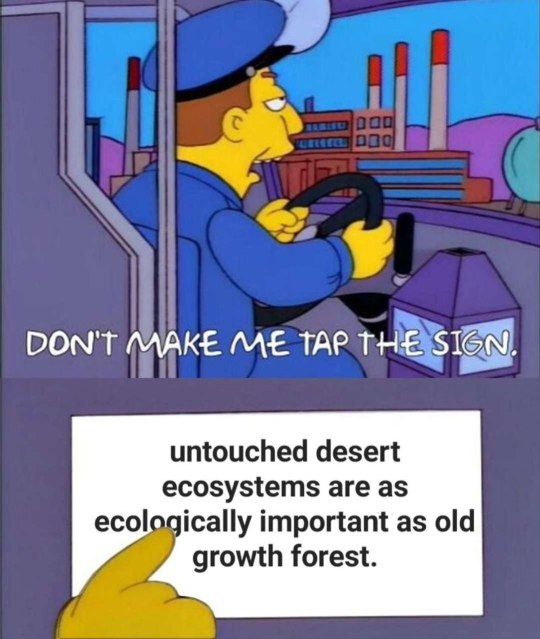#type: environment
Explore tagged Tumblr posts
Text


Source
Bad news for anyone who drinks water
#politics#us politics#government#environmentalism#health#environment#public health#pfas#the left#current events#news
374 notes
·
View notes
Text
"The world is betting heavily on carbon capture — a term that refers to various techniques to stop carbon pollution from being released during industrial processes, or removing existing carbon from the atmosphere, to then lock it up permanently.
The practice is not free of controversy, with some arguing that carbon capture is expensive, unproven and can serve as a distraction from actually reducing carbon emissions. But it is a fast-growing reality: there are at least 628 carbon capture and storage projects in the pipeline around the world, with a 60% year-on-year increase, according to the latest report from the Global CCS (Carbon Capture and Storage) Institute. The market size was just over $3.5 billion in 2024, but is projected to grow to $14.5 billion by 2032, according to Fortune Business Insights.
Perhaps the most ambitious — and the most expensive — type of carbon capture involves removing carbon dioxide (CO2) directly from the air, although there are just a few such facilities currently in operation worldwide. Some scientists believe that a better option would be to capture carbon from seawater rather than air, because the ocean is the planet’s largest carbon sink, absorbing 25% of all carbon dioxide emissions.
In the UK, where the government in 2023 announced up to £20 billion ($26.7 billion) in funding to support carbon capture, one such project has taken shape near the English Channel. Called SeaCURE, it aims to find out if sea carbon capture actually works, and if it can be competitive with its air counterpart.
“The reason why sea water holds so much carbon is that when you put CO2 into the water, 99% of it becomes other forms of dissolved carbon that don’t exchange with the atmosphere,” says Paul Halloran, a professor of Ocean and Climate Science at the University of Exeter, who leads the SeaCURE team.
“But it also means it’s very straightforward to take that carbon out of the water.”
Pilot plant
SeaCURE started building a pilot plant about a year ago, at the Weymouth Sea Life Centre on the southern coast of England. Operational for the past few months, it is designed to process 3,000 liters of seawater per minute and remove an estimated 100 tons of CO2 per year.
“We wanted to test the technology in the real environment with real sea water, to identify what problems you hit,” says Halloran, adding that working at a large public aquarium helps because it already has infrastructure to extract seawater and then discharge it back into the ocean.
The carbon that is naturally dissolved in the seawater can be easily converted to CO2 by slightly increasing the acidity of the water. To make it come out, the water is trickled over a large surface area with air blowing over it. “In that process, we can constrict over 90% of the carbon out of that water,” Halloran says.
The CO2 that is extracted from the water is run through a purification process that uses activated carbon in the form of charred coconut husks, and is then ready to be stored. In a scaled up system, it would be fed into geological CO2 storage. Before the water is released, its acidity is restored to normal levels, making it ready to absorb more carbon dioxide from the air.
“This discharged water that now has very low carbon concentrations needs to refill it, so it’s just trying to suck CO2 from anywhere, and it sucks it from the atmosphere,” says Halloran. “A simple analogy is that we’re squeezing out a sponge and putting it back.”
While more tests are needed to understand the full potential of the technology, Halloran admits that it doesn’t “blow direct air capture out the water in terms of the energy costs,” and there are other challenges such as having to remove impurities from the water before releasing it, as well as the potential impact on ecosystems. But, he adds, all carbon capture technologies incur high costs in building plants and infrastructure, and using seawater has one clear advantage: It has a much higher concentration of carbon than air does, “so you should be able to really reduce the capital costs involved in building the plants.”
Mitigating impacts
One major concern with any system that captures carbon from seawater is the impact of the discharged water on marine ecosystems. Guy Hooper, a PhD researcher at the University of Exeter, who’s working on this issue at the SeaCURE site, says that low-carbon seawater is released in such small quantities that it is unlikely to have any effect on the marine environment, because it dilutes extremely quickly.
However, that doesn’t mean that SeaCURE is automatically safe. “To understand how a scaled-up version of SeaCURE might affect the marine environment, we have been conducting experiments to measure how marine organisms respond to low-carbon seawater,” he adds. “Initial results suggest that some marine organisms, such as plankton and mussels, may be affected when exposed to low-carbon seawater.”
To mitigate potential impacts, the seawater can be “pre-diluted” before releasing it into the marine environment, but Hooper warns that a SeaCURE system should not be deployed near any sensitive marine habitats.
There is rising interest in carbon capture from seawater — also known as Direct Ocean Capture or DOC — and several startups are operating in the field. Among them is Captura, a spin off from the California Institute of Technology that is working on a pilot project in Hawaii, and Amsterdam-based Brineworks, which says that its method is more cost-effective than air carbon capture.
According to Stuart Haszeldine, a professor of Carbon Capture and Storage at the University of Edinburgh, who’s not involved with SeaCURE, although the initiative appears to be more energy efficient than current air capture pilot tests, a full-scale system will require a supply of renewable energy and permanent storage of CO2 by compressing it to become a liquid and then injecting it into porous rocks deep underground.
He says the next challenge is for SeaCURE to scale up and “to operate for longer to prove it can capture millions of tons of CO2 each year.”
But he believes there is huge potential in recapturing carbon from ocean water. “Total carbon in seawater is about 50 times that in the atmosphere, and carbon can be resident in seawater for tens of thousands of years, causing acidification which damages the plankton and coral reef ecosystems. Removing carbon from the ocean is a giant task, but essential if the consequences of climate change are to be controlled,” he says."
-via CNN, April 29, 2025
#carbon capture#environment#co2#emissions#carbon emissions#ocean#seawater#uk#united kingdom#europe#climate news#climate action#good news#hope
194 notes
·
View notes
Text

176/327 (KO-FI♡)
S9E04, “Slumber Party”
#spn#spn fan art#supernatural#supernatural art#supernatural fanart#spn fanart#supernatural fan art#supernatural stills#lexidoodledoo#other#environment#embellished#s9#faceless#salmondean#procreate#artists on tumblr#dean winchester#sam winchester#spn s9#supernatural season 9#spn 9x04#charlie bradbury#spn dorothy#drew this after watching wicked !#charlie/dorothy#charlie x dorothy
171 notes
·
View notes
Text

Crisp Point Lighthouse
Originally built on 15 acres of land with a quarter mile of lake frontage, the lighthouse grounds now consist of less than 3 acres due to the continuous erosion from Lake Superior. In 1996, Crisp Point Lighthouse was listed as the most endangered lighthouse in the United States.
#lighthouse#crisp point lighthouse#artists on tumblr#lake superior#lake#water#waves#environment#landscape#illustration#traditional art#digital art#mine
193 notes
·
View notes
Text
ANIMALS NEED THEIR HABITATS. PLEASE PLEASE PLEASE BLOW STUFF UP. IM POSTING THIS ON MY OTHER ACCOUNT TOO.
On April 16th 2025 the US federal government has proposed to change the interpretation of the endangered species act so that it no longer protects habitat.
This is open for public comment until the end of May 19th. Please comment and make your voice heard.
Wildlife need their habitat. If the ESA redefines harm so that habitat is no longer protected, the implications for wildlife would be catastrophic.
#HABITAT CONSERVATION#conservation#environment#enviromentalism#endangered species#endangered animals#usa#government#esa#please blow this up#please boost#PLEASE BOOST THIS UP#important#viralpost#viral#emergency#send help#time sensitive
62K notes
·
View notes
Text
A little parade of different bird species at a feeder. If you start a feeder be sure to keep it clean or mold and bacteria buildup will make the birds ill.
109 notes
·
View notes
Note
IM ASKING EVERYONE ON MY PAGE THAT HAS AN ASK BUTTON. THIS IS IMPORTANT. WE HAVE 5 MORE DAYS TO MAKE OUR VOICES HEARD. THE UNITED STATES GOV HAS PROPOSED TO CHANGE THE ENDANGERED SPECIES ACT TO NO LONGER PROTECT HABITAT. PLEASE BLOW THIS UP. THE IMPLICATIONS FOR WILDLIFE ARE CATASTROPHIC.
HEY Y'ALL THIS IS IMPORTANT!

Click here to find out more:
#ESA#politics#animals#nature#conservation#environment#USA#endangered species act#endangered#ecology#north america
63 notes
·
View notes
Text
Some 460 million metric tons of plastic are produced globally each year, out of which a staggering 91% of plastic waste is never recycled—with 12% incinerated and 79% left to end up in landfills and oceans and linger in our environment. Exposure to various elements causes the plastics to break down into microplastics (<5 mm) and nanoplastics (<1,000 nm). There is a growing public health concern as these nanoplastics (NPs) make their way into the human body through air, water, food and contact with skin. A recent study published in ACS ES&T Water has revealed that the already detrimental effects of NPs are further amplified by their ability to interact with various toxic environmental contaminants, such as heavy metal ions.
Continue Reading.
47 notes
·
View notes
Text

31 notes
·
View notes
Text

tried out photobashing! This is concept art for my species im working on :3
#artists on tumblr#my art#artwork#sketch#digital art#digital artist#small artist#oc artist#concept art#conceptual#environment art#environment#environmental concept art#illustration art#illustration#illustrators on tumblr#illustrative art#art#digital drawing#drawing#my draws#ilustration#clip studio paint#sketches#painting#digital painting#art detail#fantasy art#fantasy#fantasy world
27 notes
·
View notes
Text

by Rostyslav Zagornov
Check out Tabletop Gaming Resources for more art, tips, and tools for your game!
#Rostyslav Zagornov#environment#tree#bird#crow#raven#cold environment#snow#ice#tabletop rpg#rpg#tabletop gaming#pen & paper#roleplayer#roleplaying games#games#dnd#d&d#pathfinder#dungeons & dragons#dungeons and dragons#fantasy rpg
26 notes
·
View notes
Text


#deserts#desert#ecosystem#earth#ecology#econotego#golf course#golf equipment#golfers#mini golf#golf#ausgov#politas#auspol#tasgov#taspol#australia#fuck neoliberals#neoliberal capitalism#anthony albanese#albanese government#anti capitalism#capitalism#environmental activism#environmental#environment#enviroment art#environmetalists#enviromental#anti capitalist
100K notes
·
View notes
Text
https://english.radio.cz/beavers-build-planned-dams-protected-landscape-area-while-local-officials-still-8841536

A beaver colony in the Brdy region has gained overnight fame by building several dams in the Brdy protected landscape area, creating a natural wetland exactly where it was needed. It saved the local authorities 30 million crowns, and has the public cracking jokes about public administration and red tape.
The administration of the Brdy protected landscape area, which had gained approval for the 30 million crown project, was dealing with red tape and seeking the respective building permits from the Vltava River Basin authorities when the dam project was completed almost overnight by a local colony of beavers.
They could not have chosen their location better –erecting the dams on a bypass gully that was built by soldiers in the former military base years ago, so as to drain the area. The revitalization project drafted by environmentalists was supposed to remedy this. Bohumil Fišer, head of the Brdy Protected Landscape Area Administration says Nature took its course and the beavers created the necessary biotope conditions practically overnight.
#good news#beavers#brdy#beaver#ecosystem engineers#environmentalism#science#environment#nature#animals#Czech Republic
26K notes
·
View notes
Text

"The Forest"
An illustration I painted and turned into an animated gif. This was very tedious but I like how it turned out.
#fantasy#mythical creatures#magical creatures#fantasy art#illustration#my art#artwork#art#artists on tumblr#digital art#drawing#animated gif#animation#digital artist#digital illustration#digital drawing#digital painting#forest#nature#trees#oc art#artist#ghost#dark art#aesthetic#enviroment art#environment
52K notes
·
View notes
